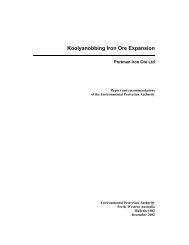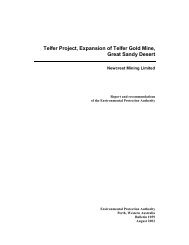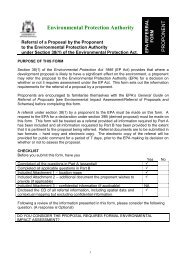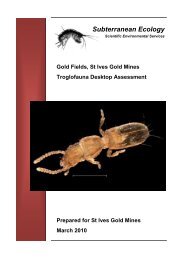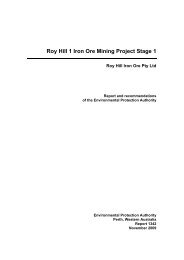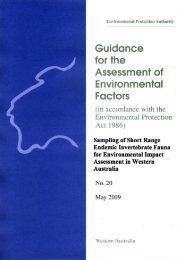- Page 1 and 2: Peel Inlet and Harvey Estuary Syste
- Page 3 and 4: EPA Report on the Peel-Harvey Progr
- Page 5 and 6: EPA Report on the Peel-Harvey Progr
- Page 7 and 8: EPA Report on the Peel-Harvey Progr
- Page 9 and 10: EPA Report on the Peel-Harvey Progr
- Page 11 and 12: EPA Report on the Peel-Harvey Progr
- Page 13 and 14: EPA Report on the Peel-Harvey Progr
- Page 15 and 16: EPA Report on the Peel-Harvey Progr
- Page 17 and 18: EPA Report on the Peel-Harvey Progr
- Page 19 and 20: EPA Report on the Peel-Harvey Progr
- Page 21 and 22: EPA Report on the Peel-Harvey Progr
- Page 23: EPA Report on the Peel-Harvey Progr
- Page 27 and 28: EPA Report on the Peel-Harvey Progr
- Page 29 and 30: EPA Report on the Peel-Harvey Progr
- Page 31 and 32: EPA Report on the Peel-Harvey Progr
- Page 33 and 34: EPA Report on the Peel-Harvey Progr
- Page 35 and 36: EPA Report on the Peel-Harvey Progr
- Page 37 and 38: EPA Report on the Peel-Harvey Progr
- Page 39 and 40: EPA Report on the Peel-Harvey Progr
- Page 41 and 42: EPA Report on the Peel-Harvey Progr
- Page 43 and 44: EPA Report on the Peel-Harvey Progr
- Page 45 and 46: EPA Report on the Peel-Harvey Progr
- Page 47 and 48: EPA Report on the Peel-Harvey Progr
- Page 49 and 50: EPA Report on the Peel-Harvey Progr
- Page 51 and 52: EPA Report on the Peel-Harvey Progr
- Page 53 and 54: EPA Report on the Peel-Harvey Progr
- Page 55 and 56: EPA Report on the Peel-Harvey Progr
- Page 57 and 58: EPA Report on the Peel-Harvey Progr
- Page 59 and 60: EPA Report on the Peel-Harvey Progr
- Page 61 and 62: Peel Inlet and Harvey Estuary Syste
- Page 63 and 64: Peel Inlet and Harvey Estuary Syste
- Page 65 and 66: Peel Inlet and Harvey Estuary Syste
- Page 67 and 68: Peel Inlet and Harvey Estuary Syste
- Page 69 and 70: Peel Inlet and Harvey Estuary Syste
- Page 71 and 72: Peel Inlet and Harvey Estuary Syste
- Page 73 and 74: Peel Inlet and Harvey Estuary Syste
- Page 75 and 76:
Peel Inlet and Harvey Estuary Syste
- Page 77 and 78:
Peel Inlet and Harvey Estuary Syste
- Page 79 and 80:
Peel Inlet and Harvey Estuary Syste
- Page 81 and 82:
Peel Inlet and Harvey Estuary Syste
- Page 83 and 84:
Peel Inlet and Harvey Estuary Syste
- Page 85 and 86:
Peel Inlet and Harvey Estuary Syste
- Page 87 and 88:
Peel Inlet and Harvey Estuary Syste
- Page 89 and 90:
Peel Inlet and Harvey Estuary Syste
- Page 91 and 92:
Peel Inlet and Harvey Estuary Syste
- Page 93 and 94:
Peel Inlet and Harvey Estuary Syste
- Page 95 and 96:
Peel Inlet and Harvey Estuary Syste
- Page 97 and 98:
Peel Inlet and Harvey Estuary Syste
- Page 99 and 100:
Peel Inlet and Harvey Estuary Syste
- Page 101 and 102:
Peel Inlet and Harvey Estuary Syste
- Page 103 and 104:
Peel Inlet and Harvey Estuary Syste
- Page 105 and 106:
Peel Inlet and Harvey Estuary Syste
- Page 107 and 108:
Peel Inlet and Harvey Estuary Syste
- Page 109 and 110:
Peel Inlet and Harvey Estuary Syste
- Page 111 and 112:
Peel Inlet and Harvey Estuary Syste
- Page 113 and 114:
Peel Inlet and Harvey Estuary Syste
- Page 115 and 116:
Peel Inlet and Harvey Estuary Syste
- Page 117 and 118:
Peel Inlet and Harvey Estuary Syste
- Page 119 and 120:
Peel Inlet and Harvey Estuary Syste
- Page 121 and 122:
Peel Inlet and Harvey Estuary Syste
- Page 123 and 124:
Peel Inlet and Harvey Estuary Syste
- Page 125 and 126:
Peel Inlet and Harvey Estuary Syste
- Page 127 and 128:
Peel Inlet and Harvey Estuary Syste
- Page 129 and 130:
Peel Inlet and Harvey Estuary Syste
- Page 131 and 132:
Peel Inlet and Harvey Estuary Syste
- Page 133 and 134:
Peel Inlet and Harvey Estuary Syste
- Page 135 and 136:
Peel Inlet and Harvey Estuary Syste
- Page 137 and 138:
Peel Inlet and Harvey Estuary Syste
- Page 139 and 140:
Peel Inlet and Harvey Estuary Syste
- Page 141 and 142:
Peel Inlet and Harvey Estuary Syste
- Page 143 and 144:
Peel Inlet and Harvey Estuary Syste
- Page 145 and 146:
Peel Inlet and Harvey Estuary Syste
- Page 147 and 148:
Peel Inlet and Harvey Estuary Syste
- Page 149 and 150:
Peel Inlet and Harvey Estuary Syste
- Page 151 and 152:
Peel Inlet and Harvey Estuary Syste
- Page 153 and 154:
Peel Inlet and Harvey Estuary Syste
- Page 155 and 156:
Peel Inlet and Harvey Estuary Syste
- Page 157 and 158:
Peel Inlet and Harvey Estuary Syste
- Page 159 and 160:
Peel Inlet and Harvey Estuary Syste
- Page 161 and 162:
Peel Inlet and Harvey Estuary Syste
- Page 163 and 164:
Peel Inlet and Harvey Estuary Syste
- Page 165 and 166:
Peel Inlet and Harvey Estuary Syste
- Page 167 and 168:
Peel Inlet and Harvey Estuary Syste
- Page 169 and 170:
Peel Inlet and Harvey Estuary Syste
- Page 171 and 172:
Peel Inlet and Harvey Estuary Syste
- Page 173 and 174:
Peel Inlet and Harvey Estuary Syste
- Page 175 and 176:
Peel Inlet and Harvey Estuary Syste
- Page 177 and 178:
Peel Inlet and Harvey Estuary Syste
- Page 179 and 180:
Peel Inlet and Harvey Estuary Syste
- Page 181 and 182:
Peel-Harvey System Management Strat
- Page 183 and 184:
Peel-Harvey System Management Strat
- Page 185 and 186:
Peel-Harvey System Management Strat
- Page 187 and 188:
Peel-Harvey System Management Strat
- Page 189 and 190:
Peel-Harvey System Management Strat
- Page 191 and 192:
Peel-Harvey System Management Strat
- Page 193 and 194:
Peel-Harvey System Management Strat
- Page 195 and 196:
Peel-Harvey System Management Strat
- Page 197 and 198:
Peel-Harvey System Management Strat
- Page 199 and 200:
Peel-Harvey System Management Strat
- Page 201 and 202:
Peel-Harvey System Management Strat
- Page 203 and 204:
Peel-Harvey System Management Strat
- Page 205 and 206:
Peel-Harvey System Management Strat
- Page 207 and 208:
Peel-Harvey System Management Strat
- Page 209 and 210:
Peel-Harvey System Management Strat
- Page 211 and 212:
Figure 4 - Examples of Nutrient-exp
- Page 213 and 214:
Peel-Harvey System Management Strat
- Page 215 and 216:
Peel-Harvey System Management Strat
- Page 217 and 218:
Peel-Harvey System Management Strat
- Page 219 and 220:
Peel-Harvey System Management Strat
- Page 221 and 222:
Peel-Harvey System Management Strat
- Page 223 and 224:
Peel-Harvey System Management Strat
- Page 225 and 226:
Peel-Harvey System Management Strat
- Page 227 and 228:
Peel-Harvey System Management Strat
- Page 229 and 230:
Peel-Harvey System Management Strat
- Page 231 and 232:
Peel-Harvey System Management Strat
- Page 233 and 234:
Peel-Harvey System Management Strat
- Page 235 and 236:
Peel-Harvey System Management Strat
- Page 237 and 238:
Peel-Harvey System Management Strat
- Page 239 and 240:
Peel-Harvey System Management Strat
- Page 241 and 242:
Peel-Harvey System Management Strat
- Page 243 and 244:
Peel-Harvey System Management Strat
- Page 245 and 246:
Peel-Harvey System Management Strat
- Page 247 and 248:
Peel-Harvey System Management Strat
- Page 249 and 250:
Peel-Harvey System Management Strat
- Page 251 and 252:
Peel-Harvey System Management Strat
- Page 253 and 254:
Peel-Harvey System Management Strat
- Page 255 and 256:
• condition and extent of remnant
- Page 257 and 258:
g) The moratorium on clearing has h
- Page 259 and 260:
) The overall environmental quality
- Page 261 and 262:
• Flooding and increased water ve
- Page 263 and 264:
g) The foreshores around the estuar
- Page 265 and 266:
Peel-Harvey Estuary System Manageme
- Page 267 and 268:
Peel-Harvey Estuary System Manageme
- Page 269 and 270:
Peel-Harvey Estuary System Manageme
- Page 271 and 272:
Peel-Harvey Estuary System Manageme
- Page 273 and 274:
Peel-Harvey Estuary System Manageme
- Page 275 and 276:
Peel-Harvey Estuary System Manageme
- Page 277 and 278:
Peel-Harvey Estuary System Manageme
- Page 279 and 280:
Peel-Harvey Estuary System Manageme
- Page 281 and 282:
Peel-Harvey Estuary System Manageme
- Page 283 and 284:
Peel-Harvey Estuary System Manageme
- Page 285 and 286:
Peel-Harvey Estuary System Manageme
- Page 287 and 288:
Peel-Harvey Estuary System Manageme
- Page 289 and 290:
Peel-Harvey Estuary System Manageme
- Page 291 and 292:
Peel-Harvey Estuary System Manageme
- Page 293 and 294:
Peel Inlet and Harvey Estuary Syste
- Page 295 and 296:
Peel Inlet and Harvey Estuary Syste
- Page 297 and 298:
Peel Inlet and Harvey Estuary Syste
- Page 299 and 300:
Peel Inlet and Harvey Estuary Syste
- Page 301 and 302:
Peel Inlet and Harvey Estuary Syste
- Page 303 and 304:
Peel Inlet and Harvey Estuary Syste
- Page 305 and 306:
Peel Inlet and Harvey Estuary Syste
- Page 307 and 308:
Peel Inlet and Harvey Estuary Syste
- Page 309 and 310:
Peel Inlet and Harvey Estuary Syste
- Page 311 and 312:
Peel Inlet and Harvey Estuary Syste
- Page 313 and 314:
Peel Inlet and Harvey Estuary Syste
- Page 315 and 316:
Peel Inlet and Harvey Estuary Syste
- Page 317 and 318:
Peel Inlet and Harvey Estuary Syste
- Page 319 and 320:
Peel Inlet and Harvey Estuary Syste
- Page 321 and 322:
Peel Inlet and Harvey Estuary Syste
- Page 323 and 324:
Fertiliser advice to farmers Peel I
- Page 325 and 326:
Peel Inlet and Harvey Estuary Syste
- Page 327 and 328:
Peel Inlet and Harvey Estuary Syste
- Page 329 and 330:
Peel Inlet and Harvey Estuary Syste
- Page 331 and 332:
2.2.1 Integrated catchment manageme
- Page 333 and 334:
2.2.5 Fertiliser advice to farmers
- Page 335 and 336:
2.3.2.1 Monitor point sources (P1.0
- Page 337 and 338:
2.3.2.7 Catchment management succes
- Page 339 and 340:
2.5.1 Estuary monitoring and manage
- Page 341 and 342:
2.6.3 Stratification (P1.08:2.23) 2
- Page 343 and 344:
2.9.1 Weed monitoring, harvesting a
- Page 345 and 346:
2.10.2 Dawesville Channel - Aborigi
- Page 347 and 348:
2.11.8 Dawesville Channel - impleme
- Page 349 and 350:
2.13.2 Liquid waste disposal for ne
- Page 351 and 352:
2.15.2 Compliance auditing (M17) 2.
- Page 353:
EPA Report on the Peel-Harvey Progr



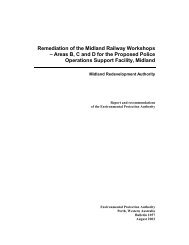
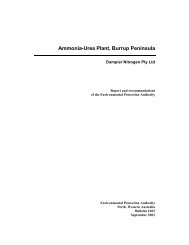
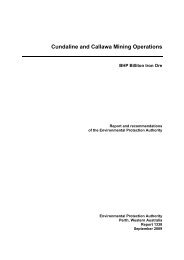
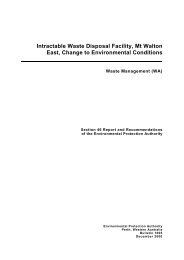
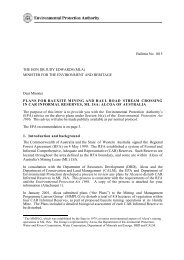
![[Project Title] - Environmental Protection Authority - The Western ...](https://img.yumpu.com/29001740/1/184x260/project-title-environmental-protection-authority-the-western-.jpg?quality=85)
